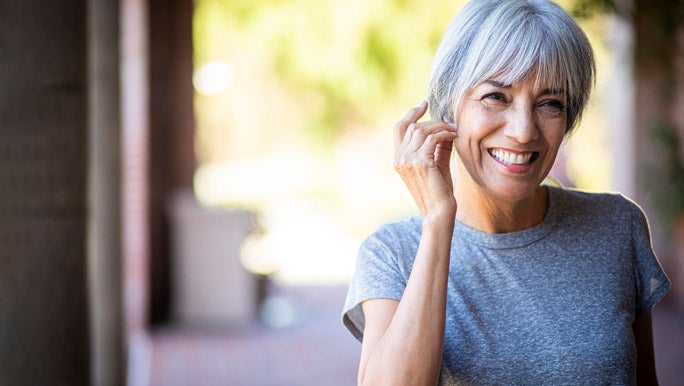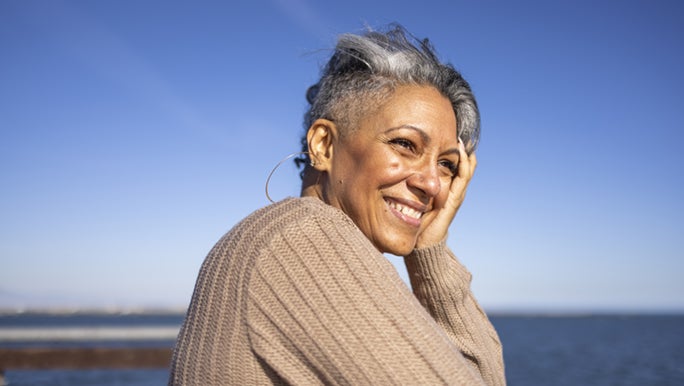How to transition to grey hair gracefully

Key points
- Your hair colour is determined by pigment-producing cells in our hair follicles called melanocytes.
- Stress may cause hair to turn grey due to a chemical called norepinephrine.
- You could transition to grey naturally or use highlights to help you along.
- It’s important to take proper care of your hair as it goes grey.
We all want to look good and feel our best, and for most of us, going grey is inevitable. Some people may start greying in their mid-thirties, others don’t start until ten years later. By the time we hit 50, half of us may have lots of greys.
Managing grey hair may feel like a full-time job. But luckily for us, grey hair is having a bit of a moment. So, if you’re tired of home dye jobs or expensive trips to the hairdresser, there’s never been a better time to embrace your greys.
What causes grey hair?
Your hair colour is determined by pigment-producing cells in our hair follicles called melanocytes. As we age, the stem cells that produce melanocytes begin to die, leading to transparent hair that lacks colour and has a grey or white appearance.
Genetic factors determine when you’ll start going grey (and to what extent), and unfortunately there’s nothing you can do to prevent it.
Does stress cause grey hair?
Yes! A recent study found that stress causes the release of a chemical called norepinephrine into the hair follicle where it turns the melanocyte stem cells into pigment cells. These cells then exit the follicles and once they’re gone no new pigment cells replace them.
But keep in mind that most grey hair isn’t related to stress. It’s usually simple genetics – so you can thank (or not) your parents!

Your hair colour is determined by pigment-producing cells in our hair follicles called melanocytes.
How do I transition to grey?
So, you’ve decided to go for it and let your grey flag fly! But there’s more to going grey than simply cancelling your next root touch-up at the hairdresser. Transitioning to grey hair takes time no matter which way you do it, but the result is worth the wait.
Transitioning to grey naturally
Your first option is to simply grow out your current colour and with it, your greys. Depending on how fast your hair grows, this could be a slow process. If you’re brave enough, you could grow your roots out a few inches and get a short pixie cut. Transition complete!
If you’re not ready for a drastic colour change and cut, a root touch-up product is a good option. Braiding your hair is a good way to disguise the line between your coloured hair and your grey hair, and you could also use dry shampoo to blur.
Transitioning to grey with highlights
Your hairdresser could use highlights and lowlights to soften the line as your hair transitions from its dyed colour to your natural grey. You may need to see your colourist every 10-12 weeks, so this process could be expensive.
But you may save money in the long run because you’ll no longer be dyeing your hair. The transition may take as little as six months for shorter hair, but long hair may take up to a year or more to go completely grey.

As we age, the stem cells that produce melanocytes begin to die, leading to transparent hair that lacks colour and has a grey or white appearance.
Is grey hair coarser than other hair?
Contrary to popular belief, grey hair is finer (not coarser!) than its pigment-rich counterparts. But it's also more brittle because it begins to lose its elastic properties.
Oil gland production also decreases as we age, so our hair loses colour and moisture. This may cause it to feel dry and wiry. Grey hair is certainly a different beast, and you’ll have to treat it with care to keep it looking great.

We all want to look good and feel our best, and for most of us, going grey is inevitable.
How do I take care of my grey hair?
It’s now more important than ever to take proper care of your hair. Some people find that their natural grey hair can go brassy, using a silver or purple toning shampoo and conditioner will help keep it looking bright and fresh. A heavier conditioner may also help since grey hair tends to be dry.
Consider using a deep-conditioning treatment once a week to nourish it. And blow-dry with a quality brush to increase shine because grey hair is naturally dull.
Your diet may also affect your hair, skin and nails, so make sure you’re eating the right things. If you’re worried that grey hair may make you look a bit older, try to take extra good care of your skin so you’re looking (and feeling) your best.
Is it time to take the plunge?
Keeping greys at bay requires time and effort, but that doesn’t mean the decision to chuck it all in and embrace a full grey ‘do is an easy one.
Our hair is a huge part of our identity and going grey is a reminder that the ageing process is happening – whether we like it or not!
But grey hair is a trend that’s (hopefully) here to stay. And we love the growing movement that’s encouraging people to recognise their natural beauty and embrace ageing.
Related:
- How to fix damaged hair (and get the healthy, shiny locks you’ve always dreamed of)
- Dermatologist tips on how to reduce the effects of ageing on your skin
- What does No Poo mean for my hair?
Reviewed by the healthylife Advisory Board October 2021.